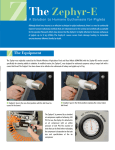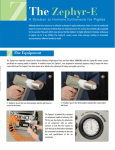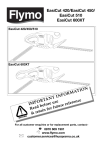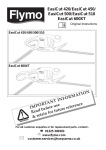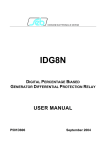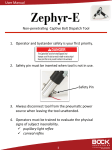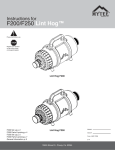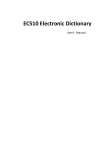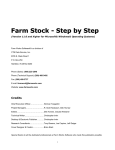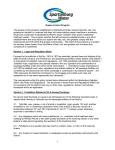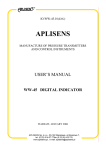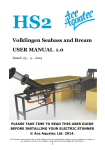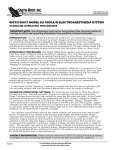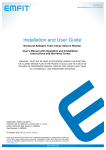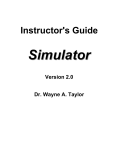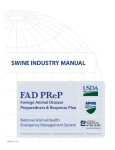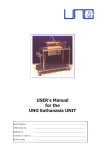Download User Manual 1. Operator and bystander safety is your first priority. 2
Transcript
User Manual Non-penetrating Captive Bolt Dispatch Tool 1. Operator and bystander safety is your first priority. 2. Safety pin must be inserted when tool is not in use. Safety Pin 3. Always disconnect tool from the pneumatic power source when leaving the tool unattended. 4. Operators must be trained to evaluate the physical signs of subject insensibility. pupillary light reflex corneal reflex Technical Support: 814-777-3890 © 2013 Bock Industries, Incorporated. All Rights Reserved. User Manual Component Identification Standard Configuration Safety Lever - Up is SAFE - Down is FIRE Guide Pneumatic Connection Air or CO2 Subject Adapter (all poultry & swine <25lbs) (120 psi) Trigger When operating tool, store safety pin here Safety Pin Safety Pin Lanyard Push safety pin thru hole Optional Goose Subject Adapter Optional Chicken Subject Adapter Technical Support: 814-777-3890 The standard subject adapter may be used for all poultry. The optional subject adapters facilitates location of the tool on layers, broilers, and geese. © 2013 Bock Industries, Incorporated. All Rights Reserved. User Manual Example Swine Restraint Tarp Straps Velcro 1) 2) 3) 4) Slice a 3' long piece of 10" PVC pipe length wise, as shown. Cut slots for the legs with clearance for paddling. Tarp straps hold the restraint crosswise on the pen. Velcro optionally used around the back of the neck. Mechanically it is important not to weaken the pipe by grossly over-sizing the slots. Installing crosswise on the pen will have the head close to the horizontal steel support of the pen. Ideally the restrain should firmly support the subject so that bolt energy is not flexing the pipe. A rigid restraint system will ensure maximum energy transferred to the subject. Technical Support: 814-777-3890 © 2013 Bock Industries, Incorporated. All Rights Reserved. User Manual Set-Up, Use & Maintenance Use 1. Remove safety pin. 2. In one motion: Press the tool firmly on target and immediately squeeze the trigger. (If the subject is large: Fire twice in quick succession as needed.) 3. Confirm physical signs of insensibility: e.g. corneal reflex Maintenance 1. 2. 3. 4. 5. 6. 7. 8. 9. Disconnect tool from pneumatic power source. Unscrew Subject Adapter from Guide to expose Bolt. Clean and disinfect exposed Bolt and Subject Adapter. Reassemble Subject Adapter and confirm Bolt moves freely in Subject Adapter. Dried matter on the inside of the Subject Adapter will block Bolt during firing and may damage Zephyr-EXL. Apply 2 drops of air tool lubrication into hose connection. Connect to air line, remove safety pin and confirm firing. Disconnect air line and replace Safety Pin. Return Zephyr-EXL to case. Return case to securely locked location. Technical Support: 814-777-3890 © 2013 Bock Industries, Incorporated. All Rights Reserved. User Manual Compressed Air Power Supply (typical) Toolup.com Item: EC510 Minimum Compressor Specifications Technical Support: 814-777-3890 © 2013 Bock Industries, Incorporated. All Rights Reserved. User Manual CO2 Power Supply (optional) Grainger.com Item: 5GAR7 Set-Up 1. Read the C02 Power Supply User Manual and identify all component parts: Regulator, Hose, Canister, Safety glasses 2. Fill the C02 canister: Sporting goods retailers carrying “Paintball” supplies, Industrial gas supply, etc. 3. Set pressure regulator to 120 psi. 4. The 9 oz. canister provides approx. 200 firings. 5. Maintain shot count record and keep spare canister nearby. 6. Canister weight is the most reliable measure of C02 level. Technical Support: 814-777-3890 © 2013 Bock Industries, Incorporated. All Rights Reserved. The Zephyr-E A Solut ion t o H u m a n e E u t h a n a s i a f o r P ig le ts Although blunt force trauma is an effective technique for piglet euthanasia, there is a need to continually improve humane euthanasia methods that are instantaneous for the animal and aesthetically acceptable for the operator. Research efforts have shown that the Zephyr-E is highly effective for humane euthanasia of piglets up to 9 kg (20lbs). The Zephyr-E causes severe brain damage leading to immediate unconsciousness followed shortly by death. The Equipment The Zephyr was originally created by the Ontario Ministry of Agriculture Food and Rural Affairs (OMAFRA) with the Zephyr-RS version created specifically for stunning rabbits in abattoirs. A modified version, the Zephyr-E, was designed for euthanasia purposes using a longer bolt with a conical bolt head.The Zephyr-E has been shown to be effective for euthanasia of turkeys and piglets up to 9 kg. ■ Zephyr-E Gun in the non-fired position with the bolt head re- ■ Zephyr-E gun in the fired position exposing the conical nylon cessed in the barrel. bolt head. The Zephyr-E is powered by a standard air compressor capable of achieving 120 PSI. For use, the Zephyr-E is attached to an air compressor with an airline pressure of 120 PSI. The number of shots that can be fired before recharging the compressor is dependent on the tank size and specifications of the air compressor The Technique To ensure safe and effective use, a sling or hammock restraint device is recommended. When the legs are placed through the 4 leg holes, the piglet is cradled, keeping it calm and motionless. Proper Positioning An “X” can be made from the top base of the ear to the inside corner of the opposite eye to help ensure proper placement of the Zephyr-E. The barrel of the Zephyr-E should be placed flush with the forehead of the piglet. Handle the gun using your dominant/preferred hand while placing the other over the shoulders of the piglet. Once properly positioned on the forehead, pull the trigger twice in a rapid fire sequence. When properly placed, the two shots on the forehead should cause immediate unconsciousness followed by death in a single step. Monitoring Signs of Consciousness Brainstem and spinal reflexes can be used to monitor whether or not the animal was rendered unconscious by the Zephyr-E. Immediately following Zephyr-E application, touch around the eye or eye lashes followed by touching the cornea (coloured surface of the eye). An unconscious animal will not blink. Any natural blinking, or blinking provoked by touch, indicates a conscious animal and the technique should be immediately reapplied. The pupil (dark centre of the eye) can also be monitored to determine unconsciousness and brain death. The pupil of a conscious animal will constrict when light is shown into the eye and dilate when the light source is removed, whereas the pupil of an unconscious animal will remain non-responsive to light. When the animal has achieved full brain death the pupil will be fixed and fully dilated. ■ Example of an UNCONSCIOUS piglet: No blink in response to touching the cornea and the pupil is fixed and dilated. ■ Example of a CONSCIOUS piglet: Blinking in response to touching the eye lashes. In addition, testing for jaw tone and a response to a nose prick can be used to test for consciousness. An unconscious animal will lack jaw tone often having an open mouth and limp tongue. For the nose prick test, pinch or prick a sensitive area of the nose. A conscious animal will jerk their head away in response to the pain whereas an unconscious animal will exhibit no response. ■ Testing for jaw tone ■ Testing the nose prick response What to Expect As soon as the trigger is pulled, the piglet will go immediately into convulsions. These are involuntary leg spasms, and they DO NOT indicate consciousness. For piglets, clonic spasms (paddling leg motion) occur first, followed by tonic spasms (rigid extension of the legs). In weaned piglets around 7 kg and above, tonic extension may briefly occur before the clonic convulsions. On average, all leg spasms stop within 3.5 minutes. ■ Clonic leg spasms: Paddling Although the onset of convulsions does indicate a severe brain injury, they do not guarantee unconsciousness; therefore, the reflexes mentioned above should be monitored throughout the convulsions to make sure the animal is rendered unconscious. If possible, check the eye reflexes immediately following Zephyr-E application, and periodically throughout the convulsions, until the spasms have stopped and the animal is completely limp and motionless. At this point, the pupil should be fixed and fully dilated indicating complete brain death. Although the heart may continue to beat for several minutes (on average 6 minutes), the animal is progressing towards death and has no chance at recovery. Prior to disposing of the animal, feel for a heartbeat to ensure that the heart has stopped beating and full cardiac arrest has occurred. ■ Tonic leg spasms: Rigid Troubleshooting Consciousness: Following Zephyr-E application, if the piglet displays signs of consciousness (ex: blinking, vocalizations, responsive pupil), an additional shot should be fired on the forehead of the piglet. Ensure that the gun is properly positioned, the barrel is flush with the surface of the forehead, and the compressor is set to 120 PSI. Gasping: If the piglet displays a gasping behaviour, an additional shot behind the ear is recommended. Gasping does not indicate a conscious animal, but the gasping may progress to rhythmic breathing which is a sign of returning to consciousness. The barrel should be pressed firmly behind the ear directed towards the back of the skull. The additional shot behind the ear targets the brainstem and will immediately knock out the respiratory centres of the brain.The gasping should stop immediately following the shot. It is recommended to fire this extra shot behind the ear once the convulsions have become less vigorous when you can safely place and fire the gun. ■ Additional shot behind the ear Prolonged Heartbeat: Occasionally, even though a piglet has progressed through the convulsion period with no signs of consciousness, the heart will continue to beat for a prolonged period of time (greater than 10 min). If the beats are faint or irregular, the heart will likely stop on its own within a few minutes, so it may be preferred to wait and check the heartbeat again in a few minutes. If the heart continues to beat for greater than 15 minutes, a secondary step may be required. As long as the animal shows no signs of consciousness (ie no blinking or pupillary response), it can be exsanguinated to cause cardiac arrest. In all cases, make sure to check back before disposing of the body to ensure the heart has stopped. ■ Feeling for a heartbeat For more information or to order: National Pork Board(s) and Swine Innovation support the research of testing the humaneness of the Zephyr gun Funding provided in part by the Ontario Ministry of Agriculture Food and Rural Affairs










